Comparison among Detailed and Simplified Calculation Methods for Thermal and Energy Assessment of the Building Envelope and the Shadings of a New Wooden nZEB House
Abstract
:1. Introduction
- the transmission heat transfer global coefficient averaged over envelope dispersing surface (H’T);
- the summer solar equivalent area of glazed elements per unit floor area (Asol,est/Asup utile);
- the specific energy need for space heating (EPH) and cooling (EPC);
- the specific global primary energy need both total (EPgl,tot) and non-renewable(EPgl,nren); and
- the efficiency of the heating (ηH), cooling (ηC), and domestic hot water systems (ηW).
- the optimization of the building envelope for the whole year and not only for heating season to reduce the energy need as much as possible (insulation, increased use of daylight, thermal activation of the mass, night natural ventilation, shading devices, etc.); and
- the increase of the heating and cooling technical systems energy efficiencies, by using the best available technology (heat recovery, increase the efficiency of air conditioning systems, etc.) and by enhancing the production of heat and electricity from on-site renewable sources (solar thermal, PV, heat pumps, district heating powered by renewable fuels, etc.).
2. Materials and Methods
- First phase: The main thermal characteristics of the building envelope are calculated and critically evaluated; and the building components (heterogeneous components and thermal bridges) and solar shading systems are analysed with both simplified (commonly used by energy performance certifiers) and detailed calculation methods (2D finite elements and dynamic codes.
- Second phase: An energy simulation of the building is carried out with dedicated steady state software; building envelope energy requirements in the heating and cooling mode are assessed and critically analysed. This phase is articulated in three steps:
- −
- energy analysis of the nZEB building using the thermal performance of building components analysed with simplified methods (from first phase);
- −
- energy analysis of the nZEB building using the thermal performance of building components analysed with detailed calculation methods (from first phase); and
- −
- energy analysis of the nZEB building using the thermal performance of building components and the energy performance of solar shading systems analysed with detailed calculation methods (from first phase).
2.1. Description of the Building
2.2. Analysis of Building Components
- thermal transmittance (U) in accordance to UNI EN ISO 6946:2008 [13];
- periodic thermal transmittance (YIE), decrement factor (f), and time shift (Δt) in accordance to UNI EN ISO 13786:2008 [14];
- surface mass index (Ms) [15]; and
- vapour condensation risk assessment (internal surface temperature and interstitial condensation) in accordance to UNI EN ISO 13788:2013 [16].
- connection between external wall and ground floor;
- connection between external wall and roof;
- connection between wall and window frame;
- connection between external wall and basement floor; and
- convex angle of the external wall.
2.3. Preliminary Evaluation of Different Shading Systems
- QH,nd: specific energy need for space heating (kWh/m2); and
- QC,nd: specific energy need for space cooling (kWh/m2).
3. Simulation Results
- first step: energy analysis of the built house taking into account the thermal performance of components and thermal bridges assessed with simplified methodology (UNI EN ISO 6946:2008 and UNI EN ISO 14683:2008);
- second step: energy analysis of the built house taking into account the presence of heterogeneous components and thermal bridges assessed with a 2D finite element analysis tool (Bisco®); and
- third step: energy analysis of the building carried out taking into account different solar shading strategies preliminary described in Section 2.3.
3.1. Energy Analysis of the nZEB Building—First Step
- design transmission and ventilation heat loss for heated space (in percentage) (Figure 14);
- design transmission heat loss for heated space analysed according to exposure, such as NE, NW, SE, SW, roof and floor (in percentage) (Figure 15);
- design transmission heat loss for heated space analysed according to different technological component, such as external wooden wall, external wooden wall—stone coated, floor on basement, ground floor, roof, windows and thermal bridges (in percentage) (Figure 16);
- energy analysis of the building envelope (in kWh/m2) subdivided as: heat transfer by transmission for the heating mode (QH,tr) and for the cooling mode (QC,tr), heat transfer by ventilation for the heating mode (QH,ve) and for the cooling mode (QC,ve), internal heat gains (Qint) and solar heat gains through windows (Qsol,w) (Figure 17 and Figure 18); and
- calculation of specific energy need for space heating (QH,nd) and cooling (QC,nd) (in kWh/m2).
3.2. Energy Analysis of the nZEB Building—Second Step
- thermal transmission losses of the roof slightly increase from 19% to 20% due to the new value of transmittance calculated with Bisco®; and
- SW wall decreases from 29% to 28% due to the new thermal bridge coefficient value from 0.138 W/mK to 0.061 W/mK.
- heat transfer by transmission for the heating mode (QH,tr) goes from 55.5 kWh/m2 to 52.9 kWh/m2 (a decrease of about 5%);
- heat transfer by transmission for the cooling mode (QC,tr) goes from 6.4 kWh/m2 to 5.6 kWh/m2 (a decrease of about 12%); and
- other values do not change.
3.3. Energy Analysis of the nZEB Building—Third Step
- preliminary evaluation of the different shading systems described in Section 2.3 to choose, among those assessed, the more performing shading strategy to improve the nZEB energy performances; and
- assessment of the nZEB building energy performances with selected shading devices.
3.3.1. Preliminary Evaluation of the Different Shading Systems
3.3.2. Energy Simulations of the nZEB Building with the Chosen Solar Shading Strategy
- solar heat gains through windows (Qsol,w) for the heating mode decrease from 35.8 kWh/m2 to 33.7 kWh/m2 (about 6%);
- solar heat gains through windows (Qsol,w) for the cooling mode decrease from 22.6 kWh/m2 to 19.3 kWh/m2 (about 15%); and
- other values do not change.
4. Conclusions
Acknowledgments
Author Contributions
Conflict of Interest
References
- Directive 2010/31/EU of The European Parliament and of the Council of 19 May 2010 on the Energy Performance of Buildings (Recast). 2010. Available online: http://eur-lex.europa.eu/legal-content/en/TXT/?uri=CELEX:32010L0031 (accessed on 8 February 2018).
- Decree of the Italian Ministry of Economic Development 26/06/2015—Applicazione Delle Metodologie di Calcolo Delle Prestazioni Energetiche e Definizione Delle Prescrizioni e dei Requisiti Minimi Degli Edifici—Adeguamento del Decreto del Ministro Dello Sviluppo Economico, 26 Giugno 2009—Linee Guida Nazionali per la Certificazione Energetica Degli Edifici. 2015. Available online: http://www.gazzettaufficiale.it/eli/id/2015/07/15/15A05198/sg (accessed on 08 February 2018). (In Italian).
- Legislative Decree 03/03/2011, n. 28—Attuazione Della Direttiva 2009/28/CE Sulla Promozione Dell’uso Dell’energia da Fonti Rinnovabili, Recante Modifica e Successiva Abrogazione Delle Direttive 2001/77/CE e 2003/30/CE. 2011. Available online: http://www.gazzettaufficiale.it/eli/id/2011/03/28/011G0067/sg (accessed on 08 February 2018). (In Italian).
- Thalfeldt, M.; Pikas, E.; Kurnitski, J.; Voll, H. Facade design principles for nearly zero energy buildings in a cold climate. Energy Build. 2013, 67, 309–321. [Google Scholar] [CrossRef]
- Kolokotsa, D.; Rovas, D.; Kosmatopoulos, E.; Kalaitzakis, K. A road map towards intelligent net zero and positive energy buildings. Sol. Energy 2011, 85, 3067–3084. [Google Scholar] [CrossRef]
- AlAjmi, A.; Abou-Ziyan, H.; Ghoneim, A. Achieving annual and monthly net-zero energy of existing building in hot climate. Appl. Energy 2016, 165, 511–521. [Google Scholar] [CrossRef]
- Wang, L.; Gwilliam, J.; Jones, P. Case study of zero energy house design in UK. Energy Build. 2009, 41, 1215–1222. [Google Scholar] [CrossRef]
- Becchio, C.; Dabbene, P.; Fabrizio, E.; Monetti, V.; Filippi, M. Cost optimality assessment of a single family house: Building and technical systems solutions for the NZEB target. Energy Build. 2015, 90, 173–187. [Google Scholar] [CrossRef]
- ZEBRA Project. Available online: http://www.zebra-monitoring.enerdata.eu/ (accessed on 30 October 2017).
- Bruno, R.; Carpino, C.; Arcuri, N. The passive house in Mediterranean area: parametric analysis and dynamic simulation of the thermal behaviour of an innovative prototype. Energy Procedia 2015, 82, 533–539. [Google Scholar] [CrossRef]
- Ascione, F.; De Masi, R.F.; de Rossi, F.; Ruggiero, S.; Vanoli, G.P. Optimization of building envelope design for nZEBs in Mediterranean climate: Performance analysis of residential case study. Appl. Energy 2016, 183, 938–957. [Google Scholar] [CrossRef]
- Decree of the President of the Italian Republic 26/08/1993 n.412—Regolamento Recante Norme per la Progettazione, L’installazione, L’esercizio e la Manutenzione Degli Impianti Termici Degli Edifici ai Fini del Contenimento dei Consumi di Energia, in Attuazione dell’art. 4, Comma 4, della Legge 9 Gennaio 1991, n. 10. 1993. Available online: http://www.gazzettaufficiale.it/eli/id/1993/10/14/093G0451/sg (accessed on 8 February 2018). (In Italian).
- UNI. UNI EN ISO 6946, Building Components and Building Elements—Thermal Resistance and Thermal Transmittance—Calculation Method; UNI: Milan, Italy, 2008. [Google Scholar]
- UNI. UNI EN ISO 13786, Thermal Performance of Building Components—Dynamic Thermal Characteristics—Calculation Methods; UNI: Milan, Italy, 2008. [Google Scholar]
- Legislative Decree 29/12/2006, n. 311—Disposizioni Correttive ed Integrative al Decreto Legislativo 19 Agosto 2005, n. 192, Recante Attuazione Della Direttiva 2002/91/CE, Relativa al Rendimento Energetico Nell’edilizia. 2006. Available online: http://www.gazzettaufficiale.it/eli/id/2007/02/01/007G0007/sg (accessed on 8 February 2018). (In Italian).
- UNI. UNI EN ISO 13788, Hygrothermal Performance of Building Components and Building Elements—Internal Surface Temperature to Avoid Critical Surface Humidity and Interstitial Condensation—Calculation Methods; UNI: Milan, Italy, 2013. [Google Scholar]
- UNI. UNI EN ISO 10211, Thermal Bridges in Building Construction—Heat Flows and Surface Temperatures—Detailed Calculations; UNI: Milan, Italy, 2008. [Google Scholar]
- Physibel Software, Bisco Version 9.0w, 2008. Available online: http://www.physibel.be/ (accessed on 8 February 2018).
- UNI. UNI EN ISO 14683, Thermal Bridges in Building Construction—Linear Thermal Transmittance—Simplified Methods and Default Values; UNI: Milan, Italy, 2008. [Google Scholar]
- UNI. UNI/TS 11300-1, Prestazioni Energetiche Degli Edifici. Parte 1: Determinazione del Fabbisogno di Energia Termica per la Climatizzazione Invernale ed Estiva; UNI: Milan, Italy, 2014. (In Italian) [Google Scholar]
- Design Builder Software Ltd., Design Builder Version 4.6.0.015, 2016. Available online: http://www.designbuilder.co.uk (accessed on 8 February 2018).
- Cellai, G.; Carletti, C.; Sciurpi, F.; Secchi, S. Transparent Building Envelope: Windows and Shading Devices Typologies for Energy Efficiency Refurbishments. In Building Refurbishment for Energy Performance; Magrini, A., Ed.; Springer International Publishing: Berlin, Germany, 2014; pp. 61–118. ISBN 9783319030739. [Google Scholar]
- Carletti, C.; Sciurpi, F.; Pierangioli, L. The Energy Upgrading of Existing Buildings: Window and Shading Device Typologies for Energy Efficiency Refurbishment. Sustainability 2014, 6, 5354–5377. [Google Scholar] [CrossRef]
- Carletti, C.; Sciurpi, F.; Pierangioli, L.; Asdrubali, F.; Pisello, A.L.; Bianchi, F.; Sambuco, S.; Guattari, G. Thermal and lighting effects of an external venetian blind: Experimental analysis in a full scale test room. Build. Environ. 2016, 106, 45–56. [Google Scholar] [CrossRef]

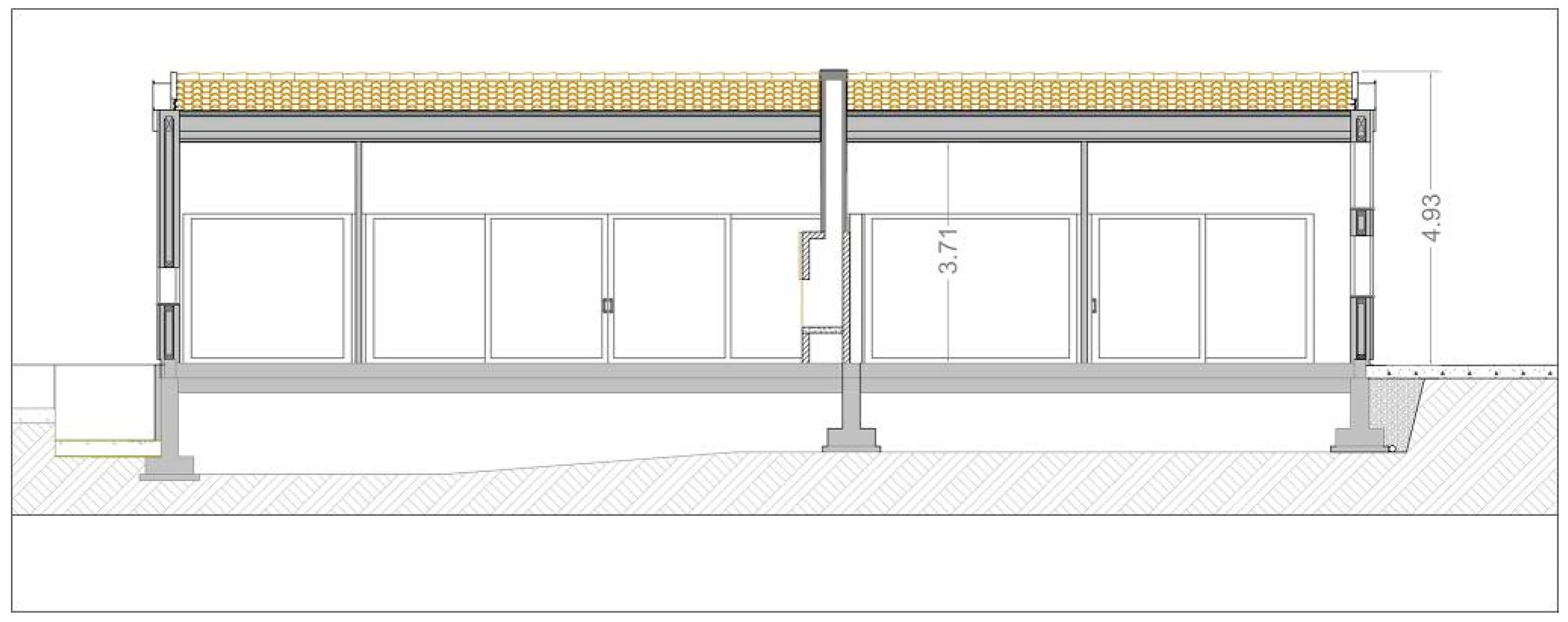

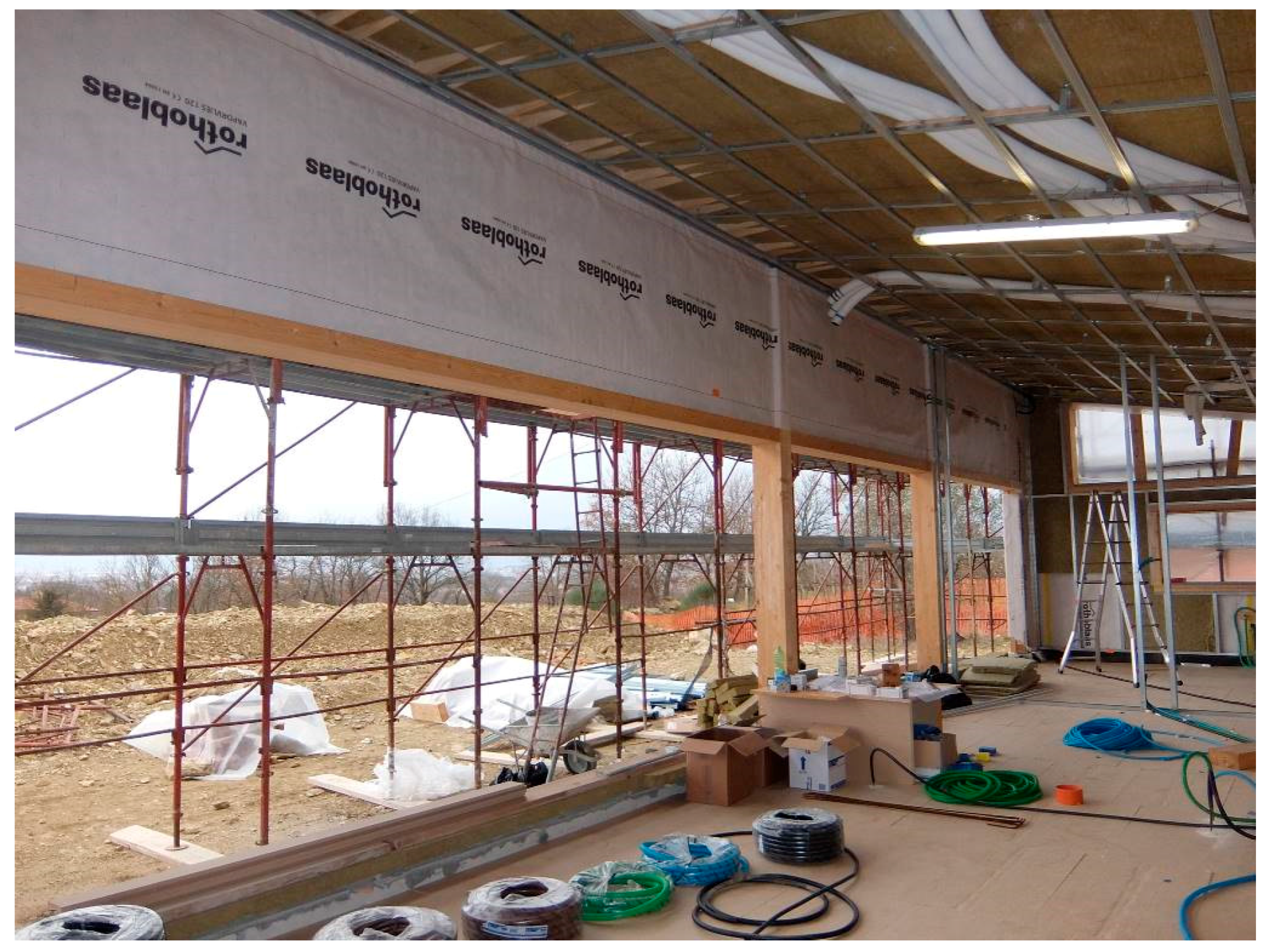


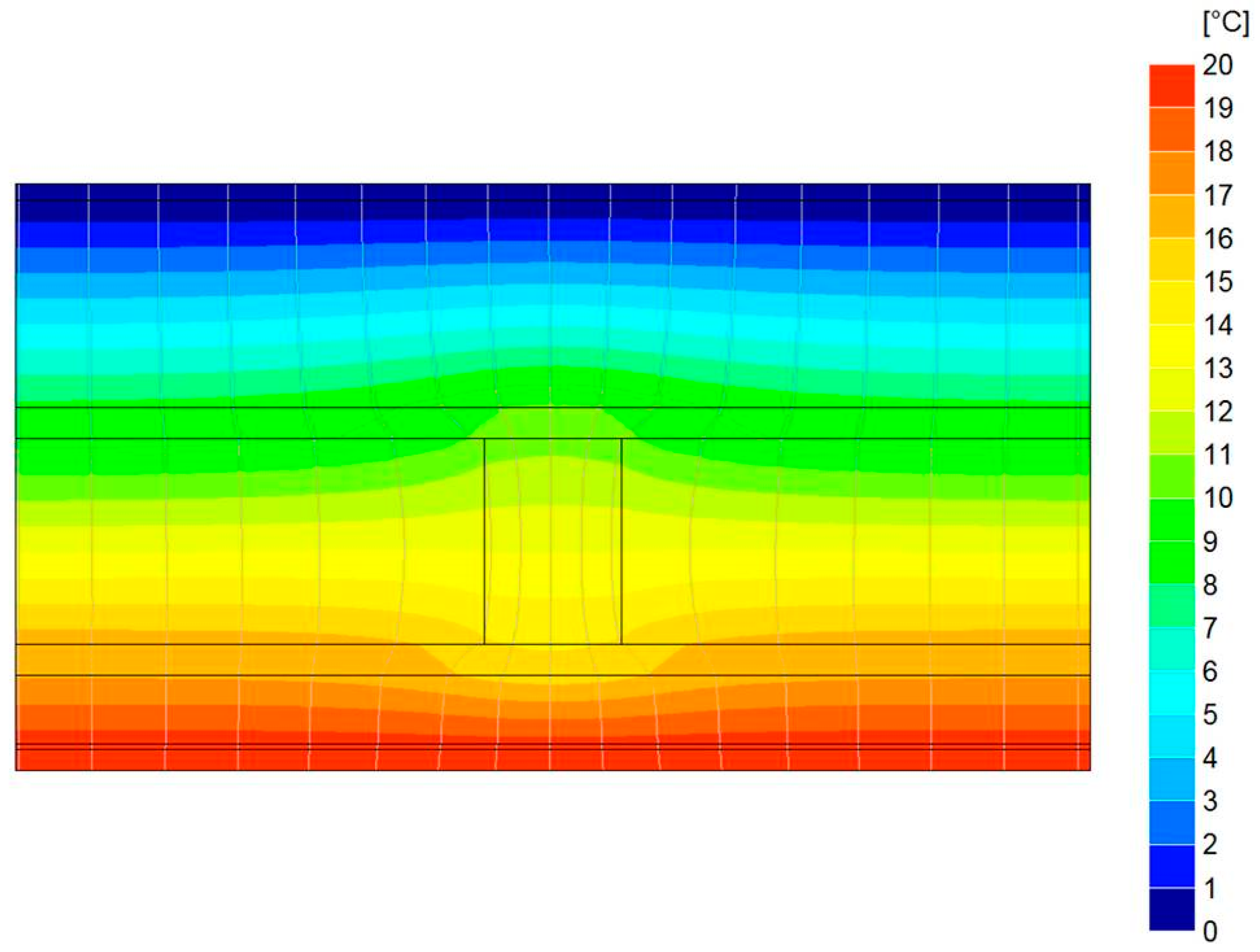


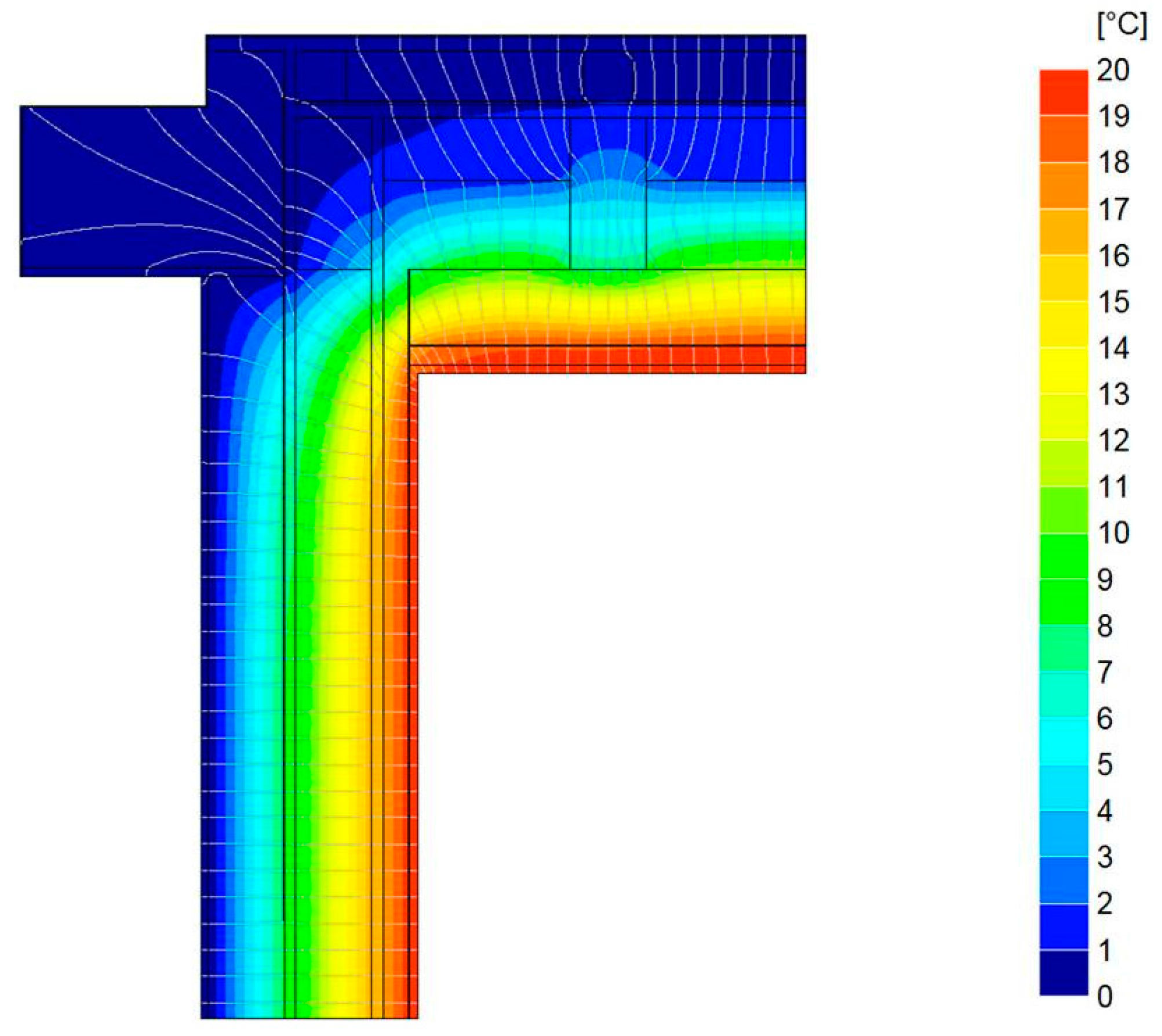
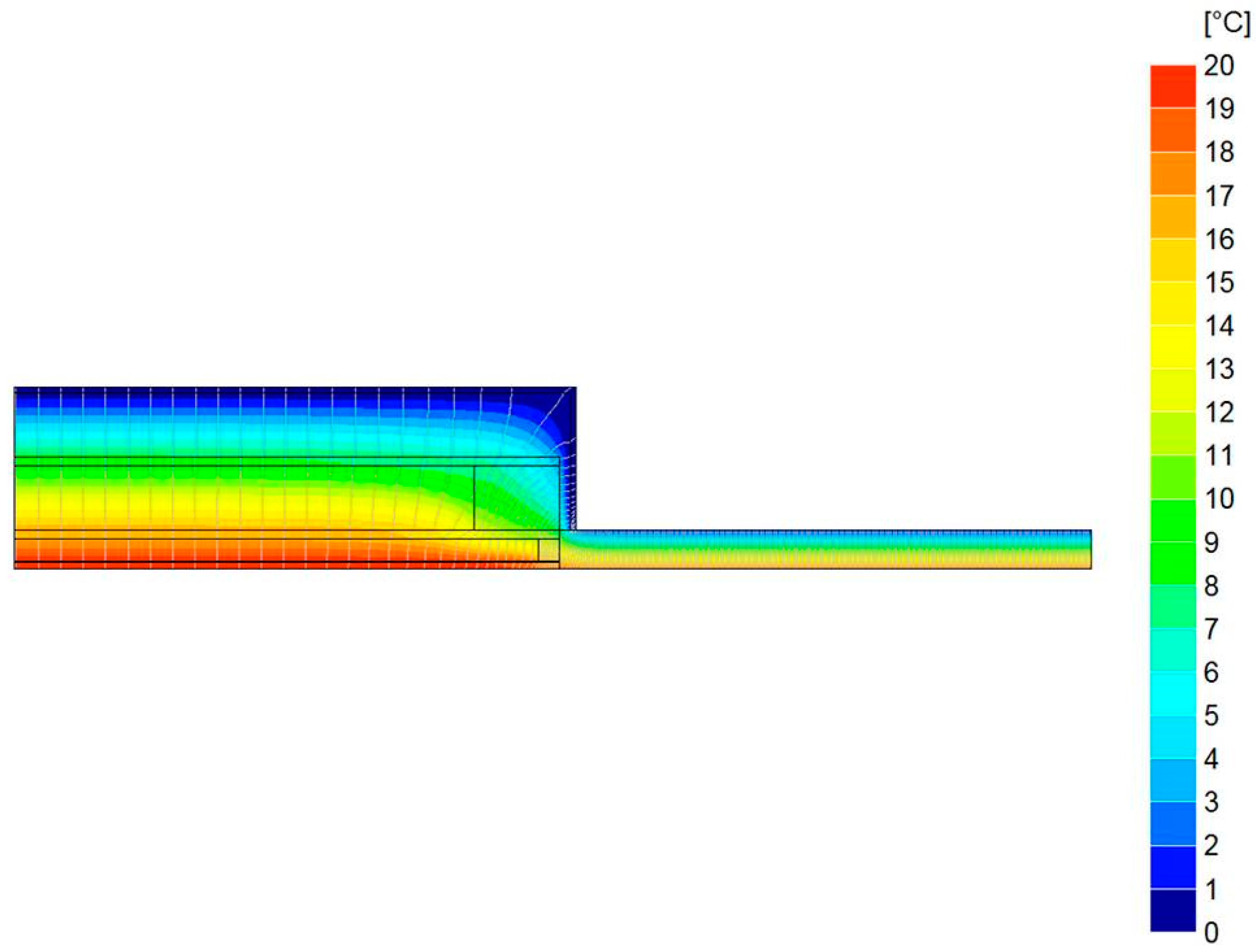
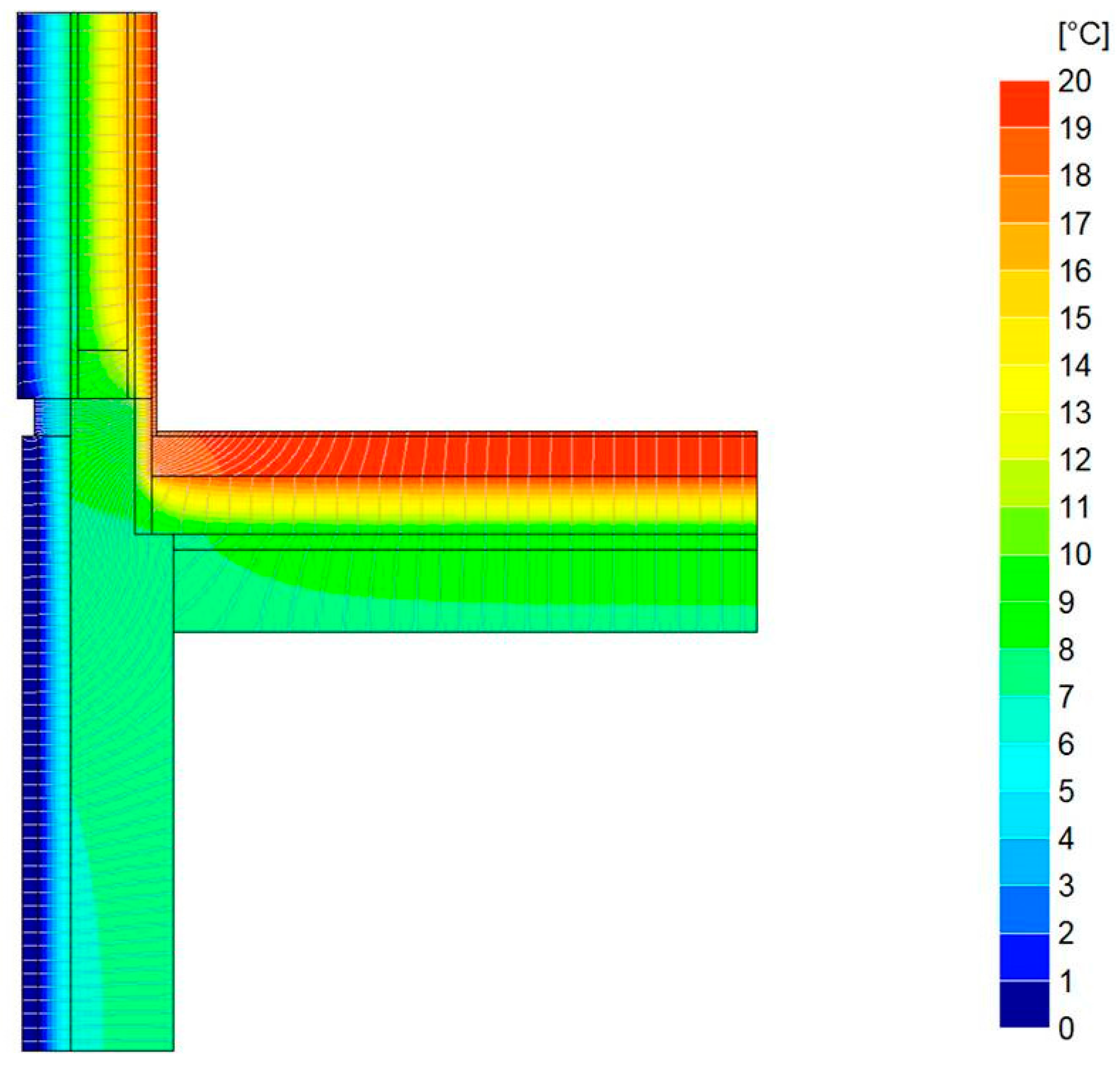
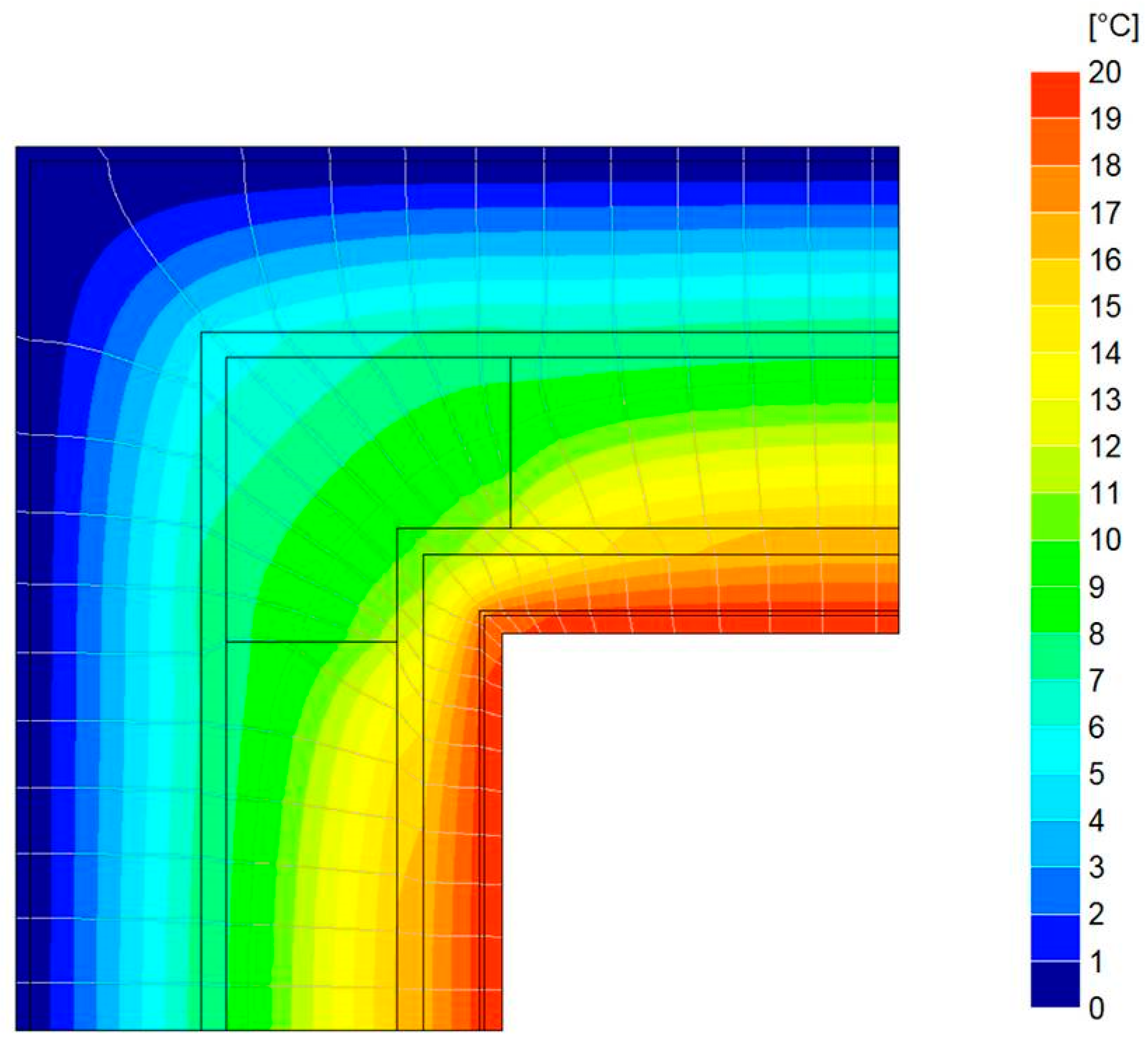
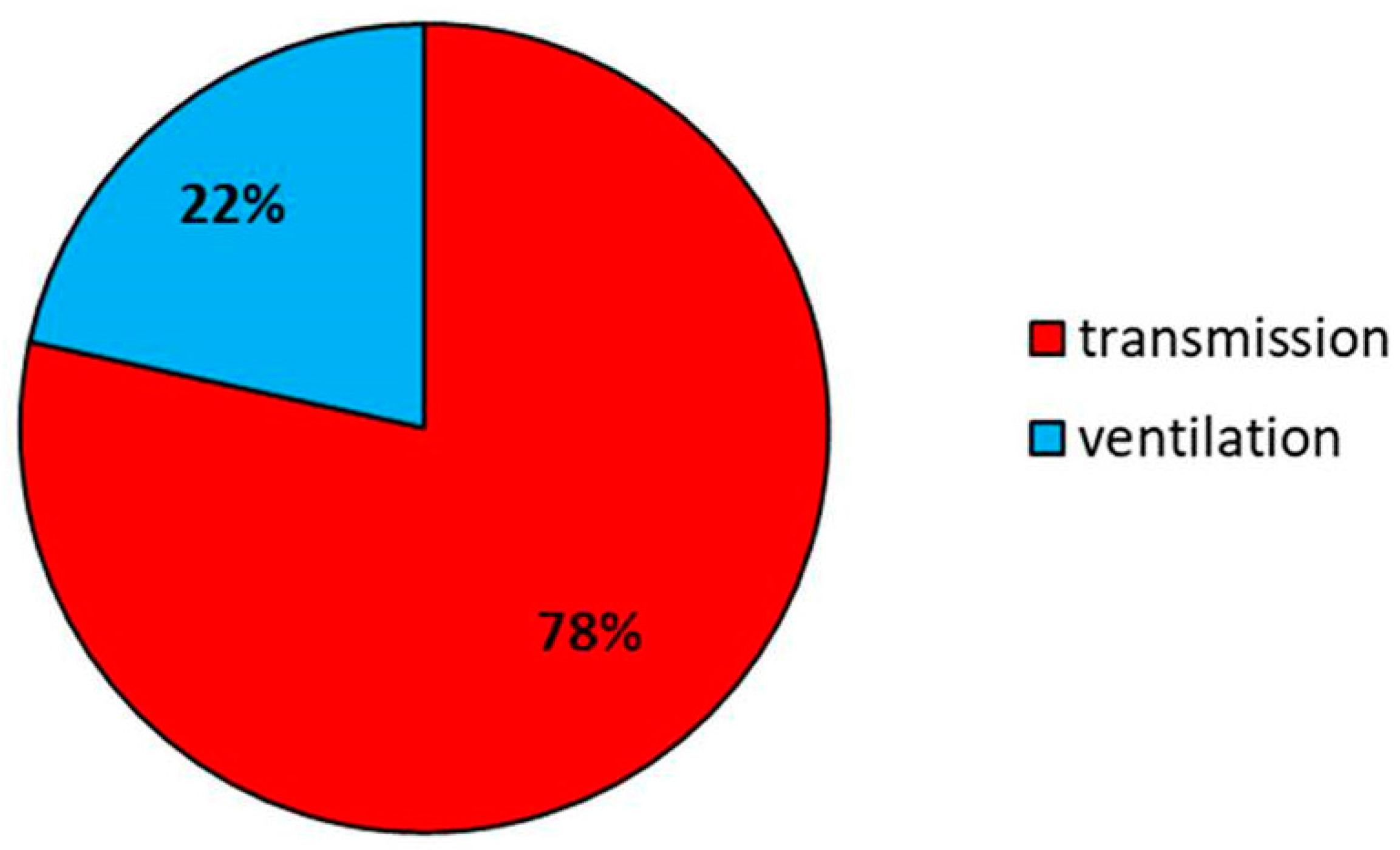
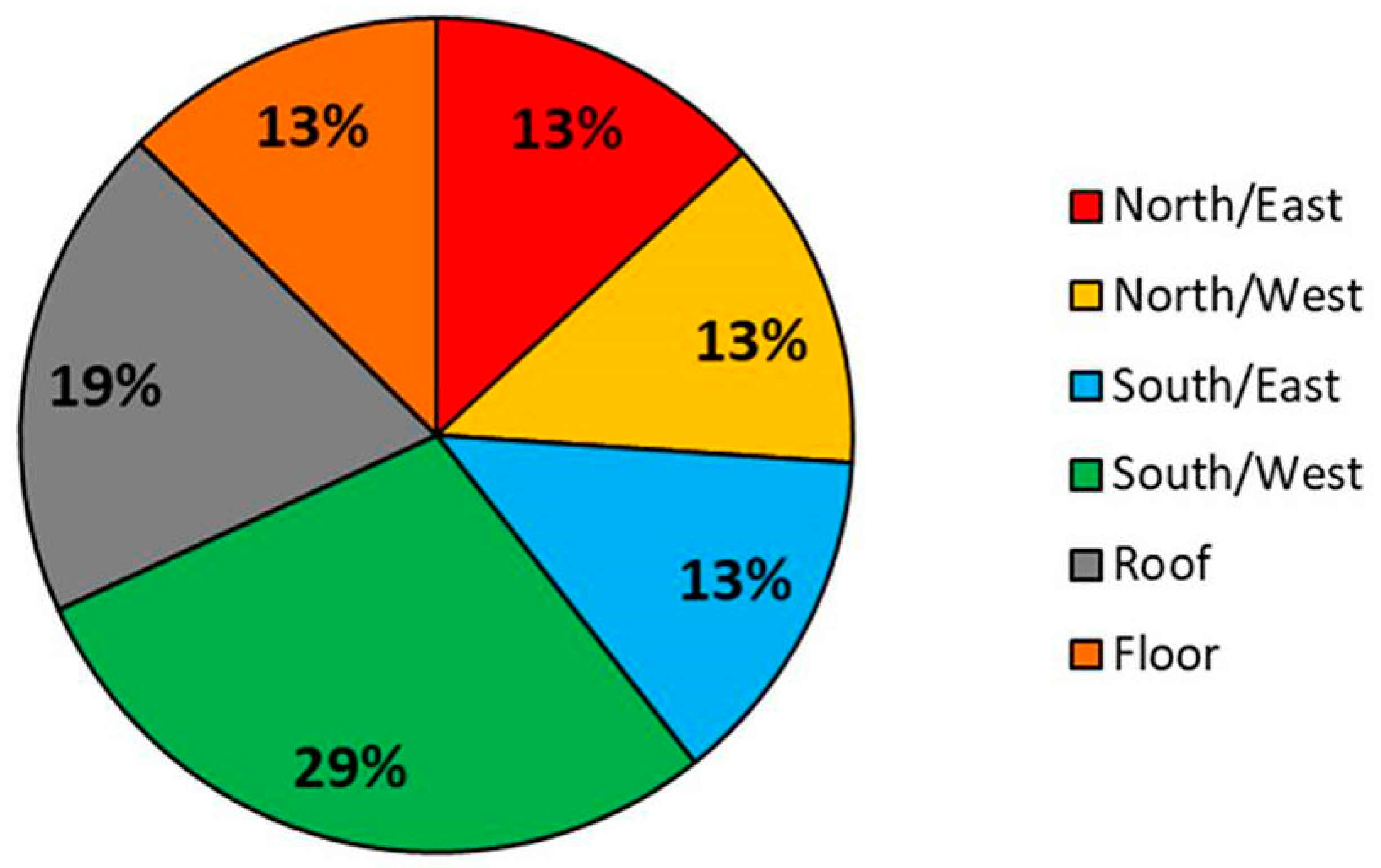
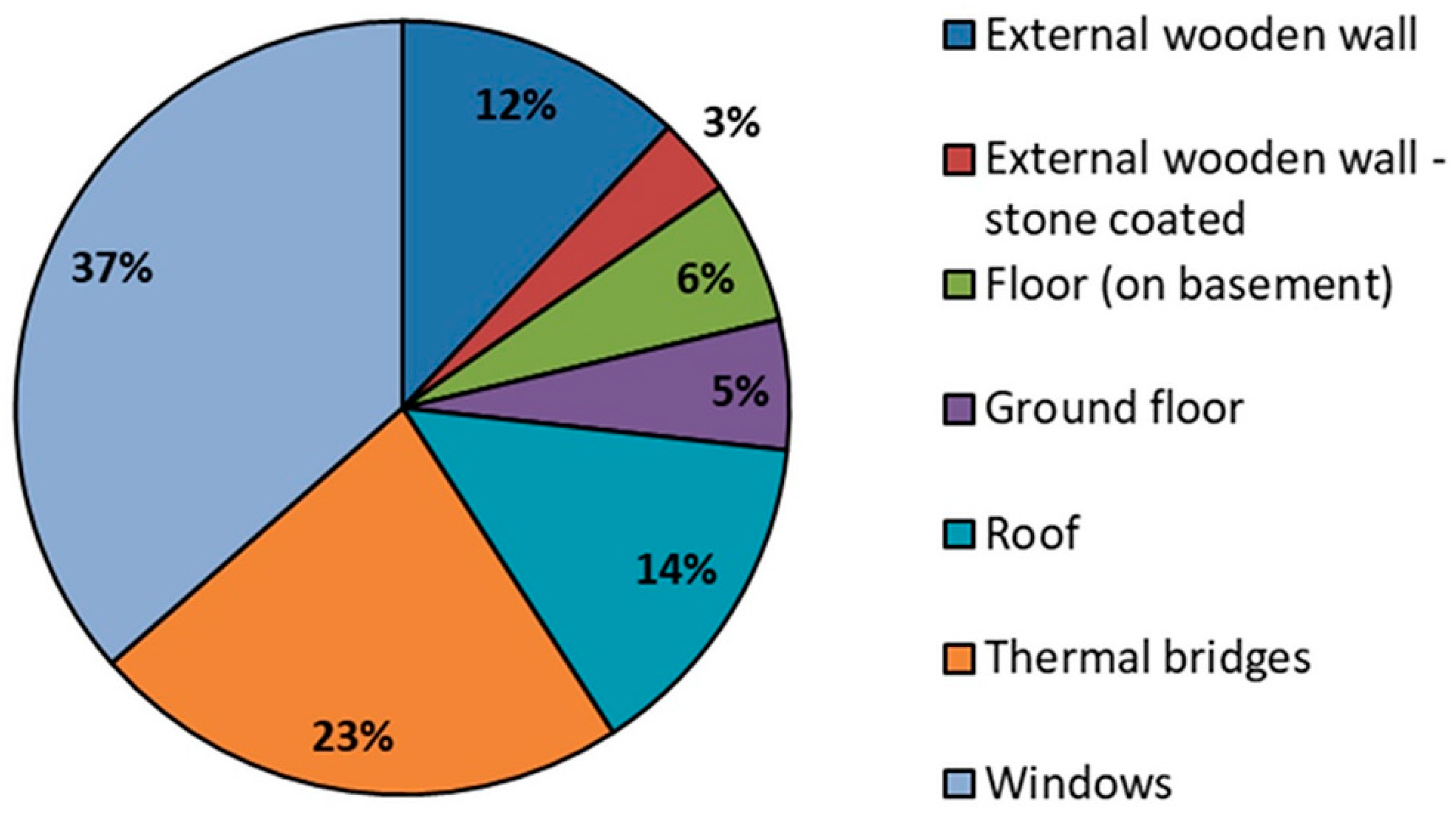
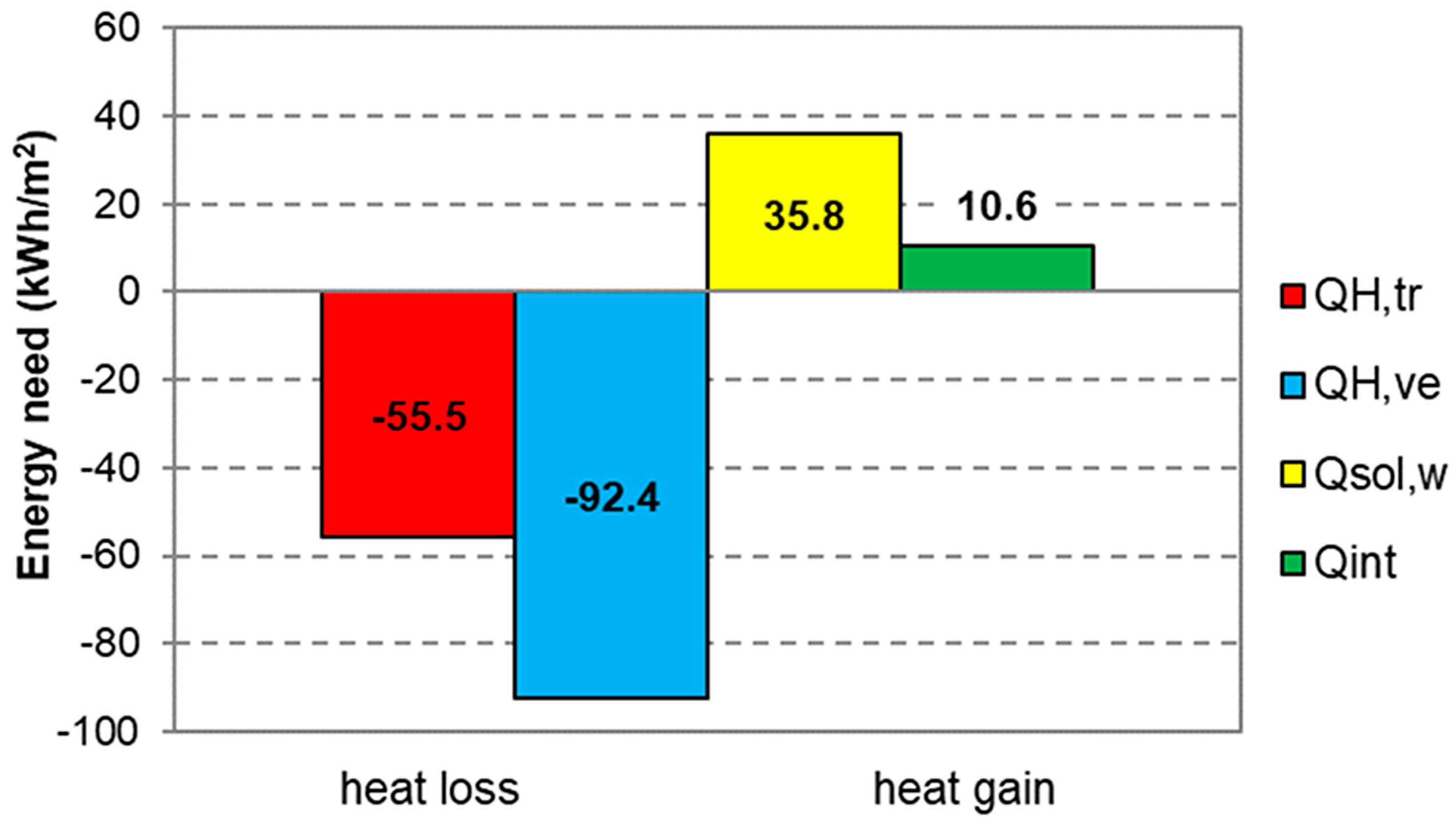
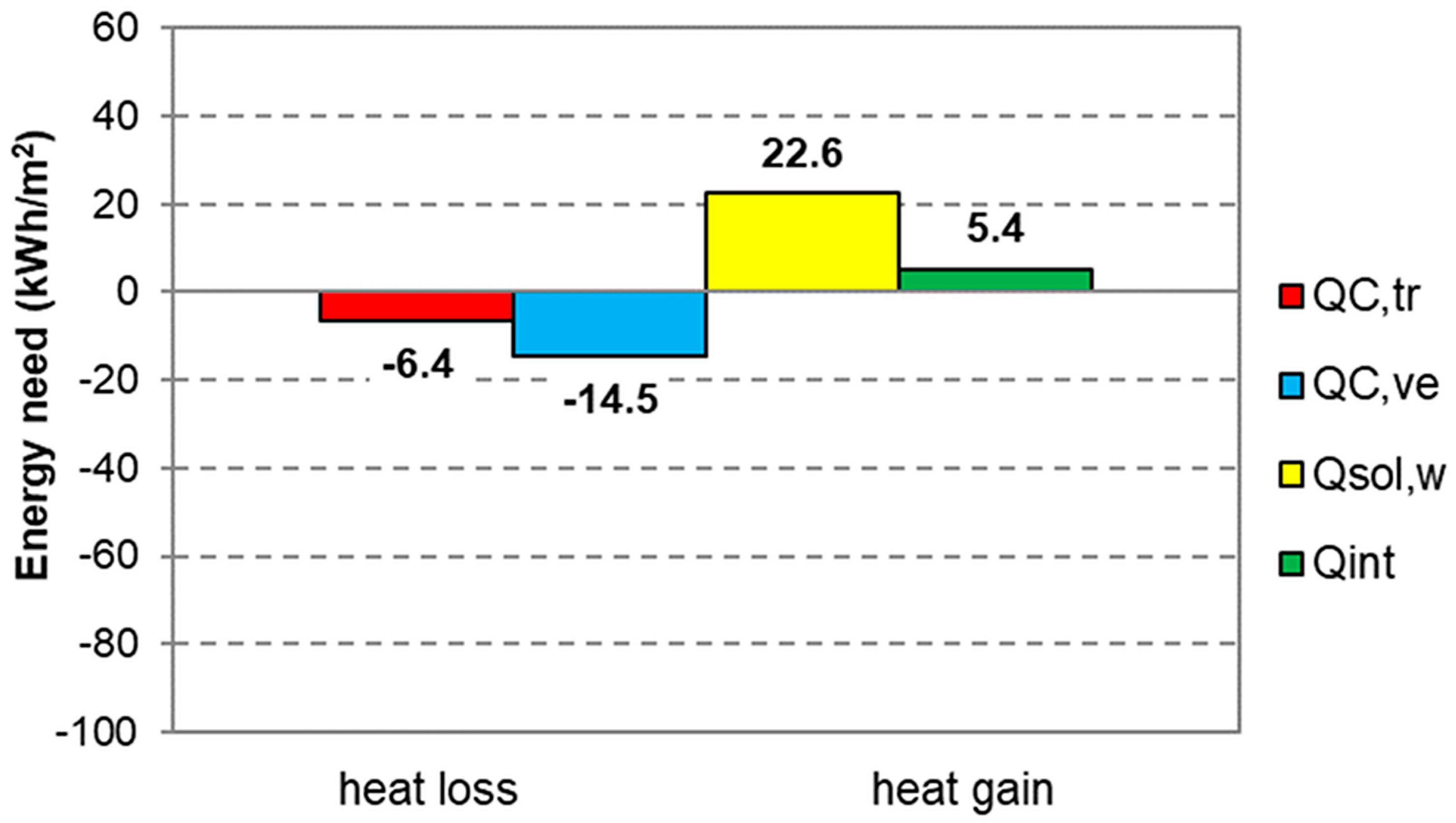
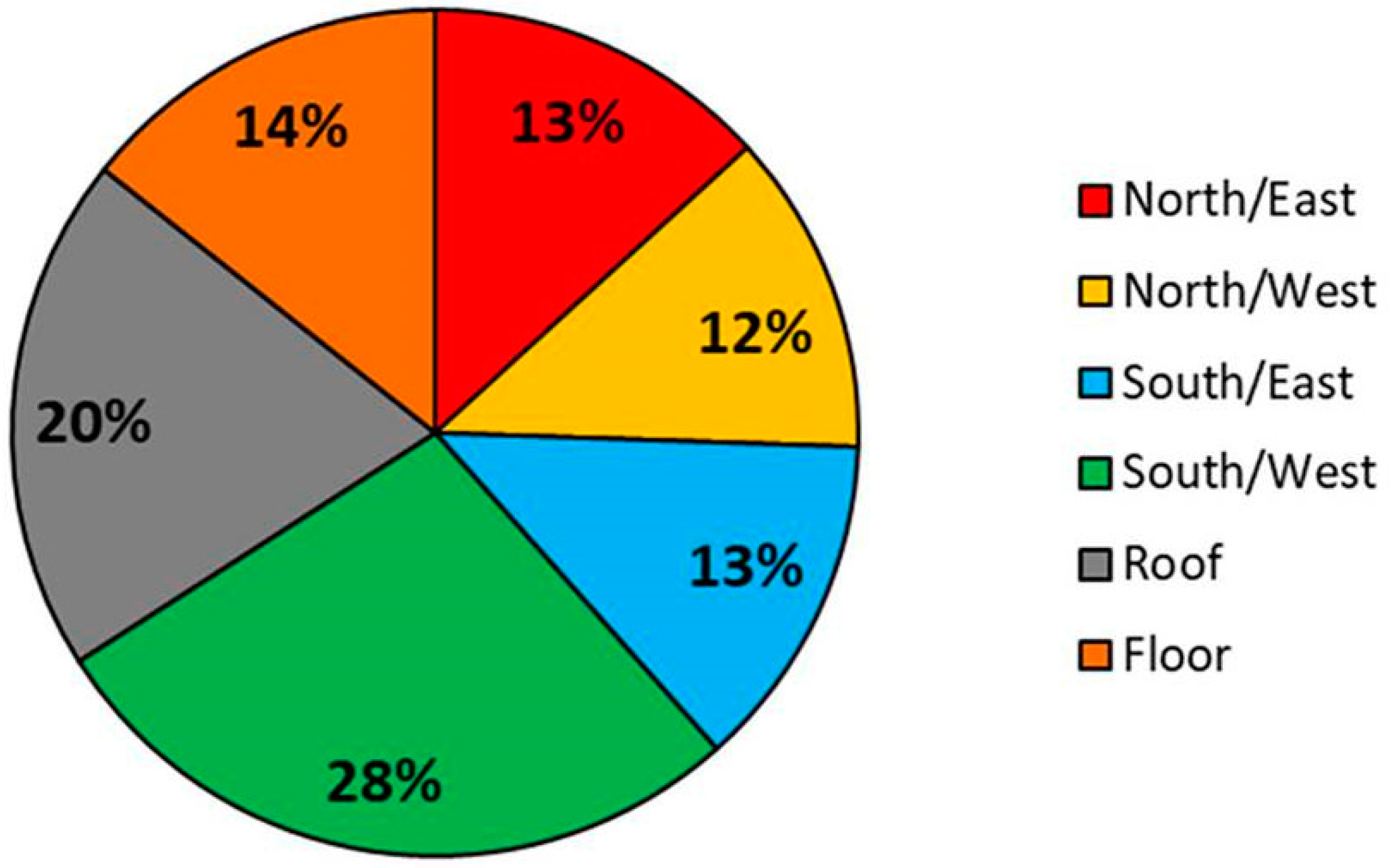

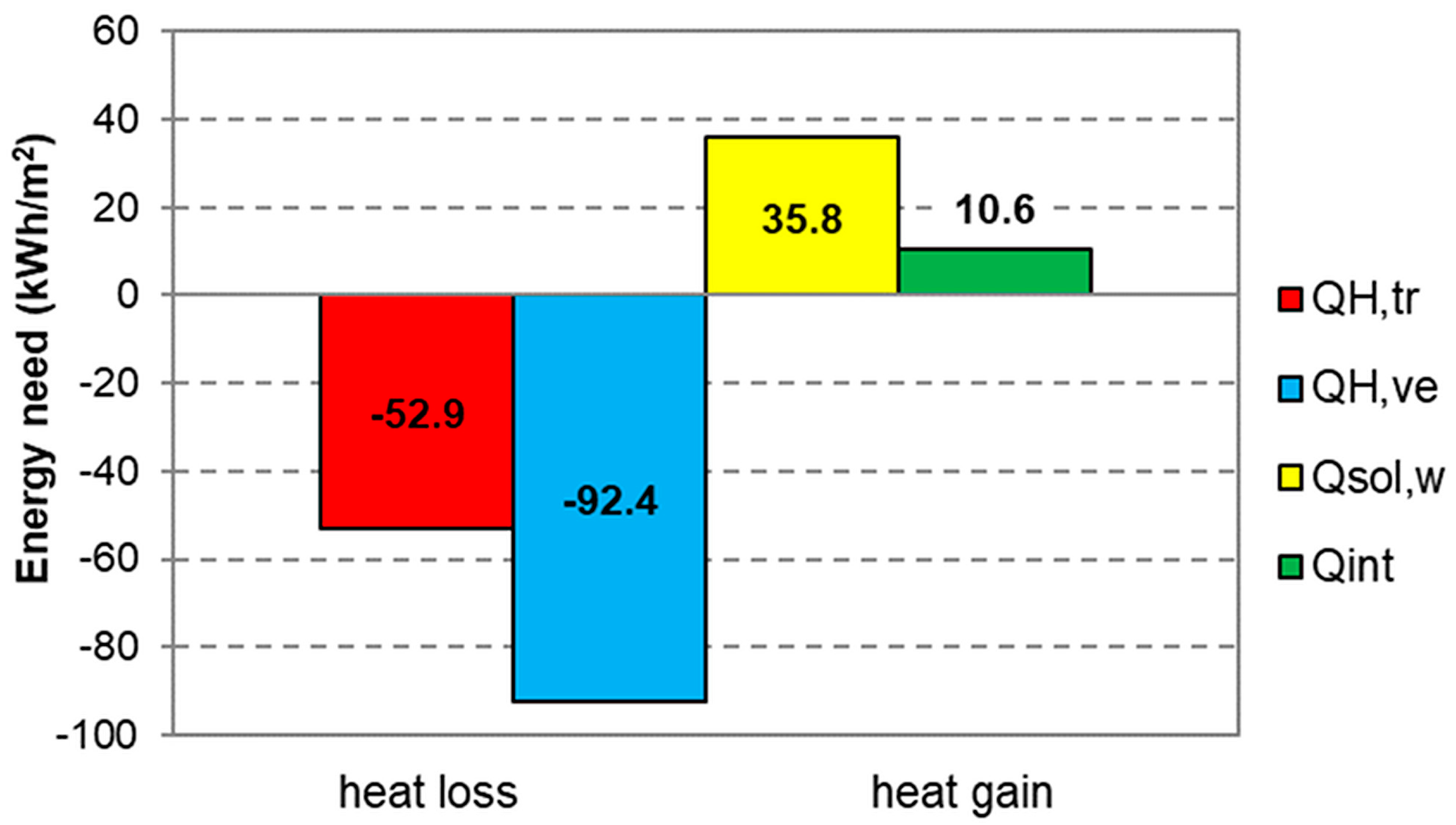

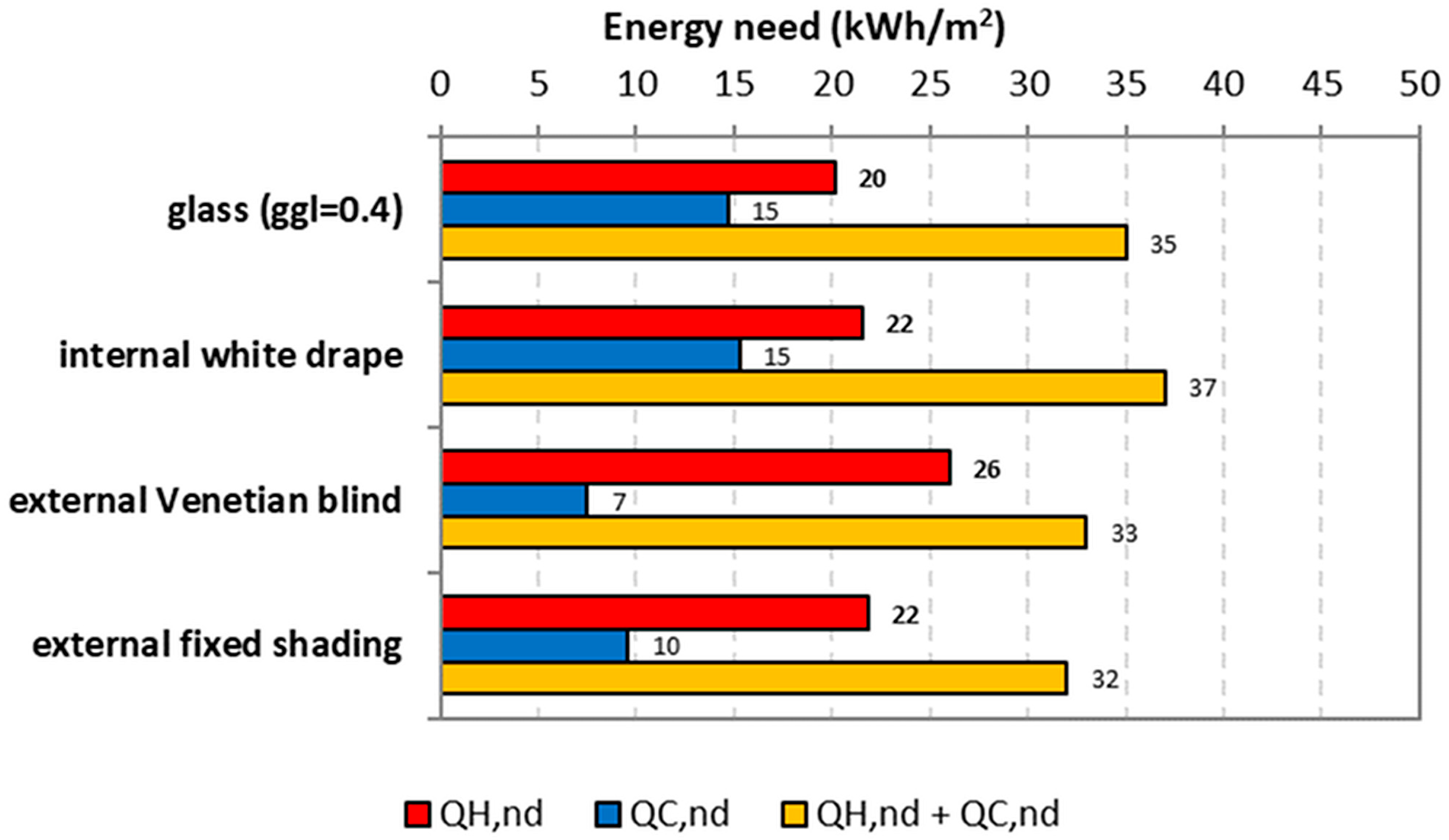

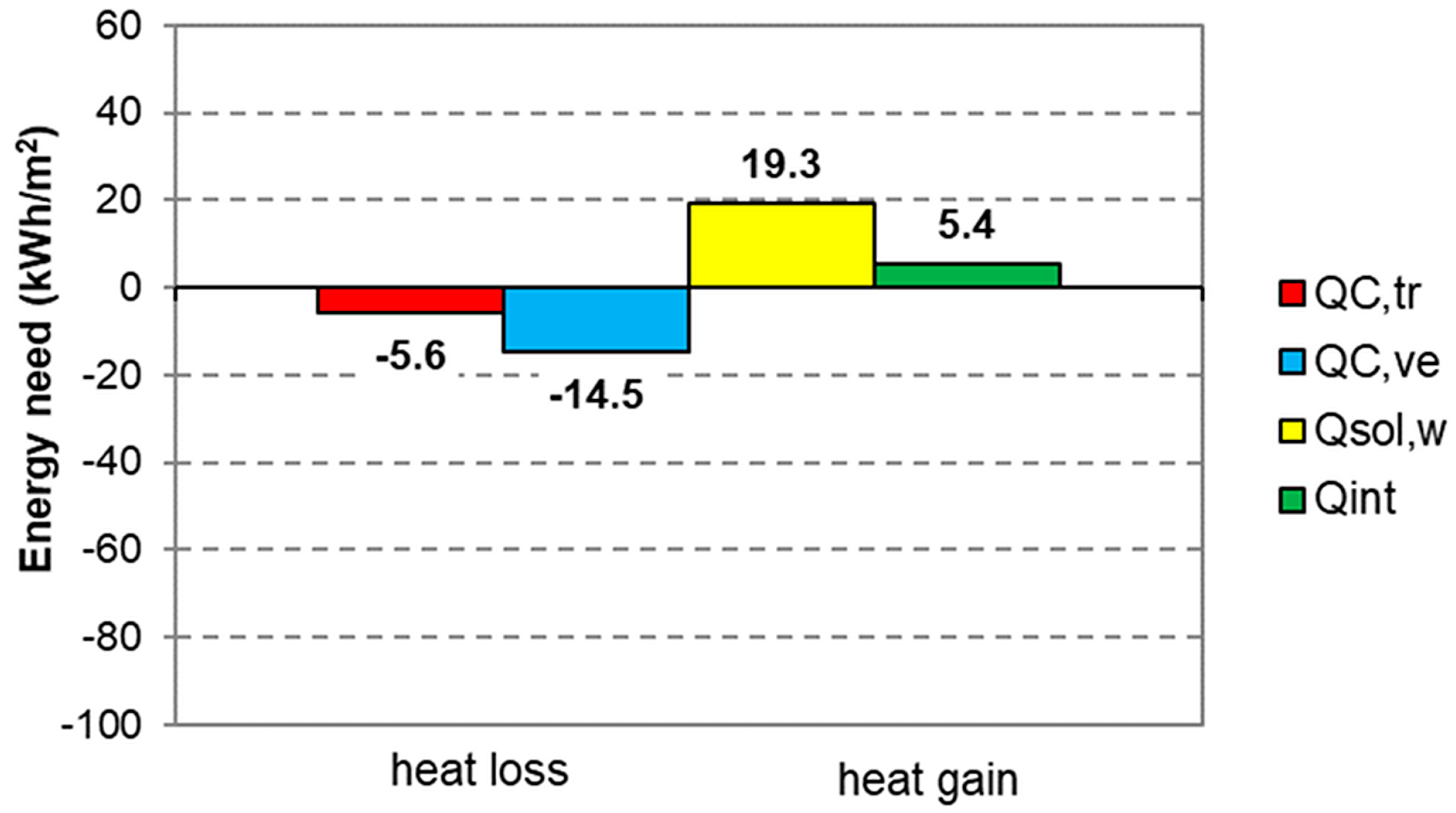
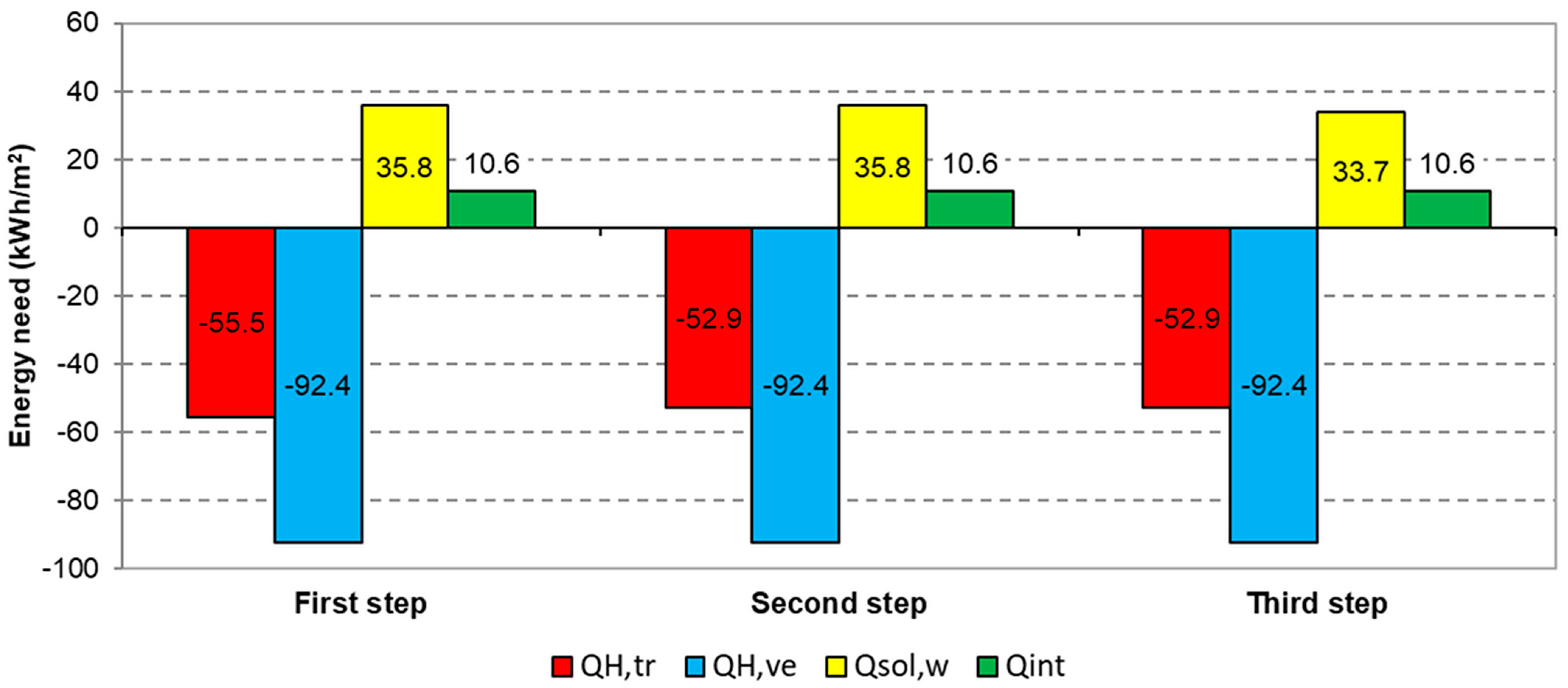

| Geographic Location | Arezzo (Italy) |
|---|---|
| Climatic zone [12] | E |
| Heating Degree Days (HDD) | 2014 |
| Heating season [12] | from 15/10 to 15/4 (183 days) |
| Floor area | 186 m2 |
| Heated volume | 631 m3 |
| Surface area to Heated volume ratio (S/V) | 0.82 m2/m3 |
| Layer | Thickness (s) (m) | Thermal Conductivity λ [W/(m·K)] | Density ρ (kg/m³) | Specific Heat Capacity cp [J/(kg·K)] |
|---|---|---|---|---|
| External wooden wall | ||||
| Gypsum plasterboard | 0.0125 | 0.250 | 900 | 1000 |
| PVC vapour barrier | 0.0030 | 0.160 | 1390 | 900 |
| Rockwool “211” | 0.0400 | 0.035 | 40 | 1030 |
| Oriented strand board | 0.0180 | 0.130 | 650 | 1700 |
| Rockwool “211” | 0.1200 | 0.035 | 40 | 1030 |
| Oriented strand board | 0.0180 | 0.130 | 650 | 1700 |
| Expanded polystyrene “EPS 100” | 0.1200 | 0.036 | 20 | 1500 |
| Cement/lime plaster | 0.0100 | 0.900 | 1800 | 1000 |
| External wooden wall—stone coated | ||||
| Gypsum plasterboard | 0.0125 | 0.250 | 900 | 1000 |
| PVC vapour barrier | 0.0030 | 0.160 | 1390 | 900 |
| Rockwool “211” | 0.0400 | 0.035 | 40 | 1030 |
| Oriented strand board | 0.0180 | 0.130 | 650 | 1700 |
| Rockwool “211” | 0.1200 | 0.035 | 40 | 1030 |
| Oriented strand board | 0.0180 | 0.130 | 650 | 1700 |
| Expanded polystyrene “EPS 100” | 0.0400 | 0.036 | 20 | 1500 |
| Stone cladding | 0.0800 | 1.500 | 2000 | 1000 |
| Floor (on basement) | ||||
| Laminate wood flooring | 0.0100 | 0.143 | 500 | 1500 |
| Reinforced concrete screed | 0.1000 | 1.490 | 2200 | 880 |
| Polyurethane foam insulation “Stiferite GT” | 0.1400 | 0.024 | 36 | 1450 |
| Reinforced concrete screed | 0.0400 | 1.490 | 2200 | 880 |
| Concrete/brick slab | 0.2000 | 0.660 | 1100 | 840 |
| Cement/lime plaster | 0.0100 | 0.900 | 1800 | 1000 |
| Ground floor | ||||
| Ceramic tiles | 0.0100 | 1.300 | 2300 | 840 |
| Reinforced concrete screed | 0.1000 | 1.490 | 2200 | 880 |
| Polyurethane foam insulation “Stiferite GT” | 0.1400 | 0.024 | 36 | 1450 |
| Reinforced concrete screed | 0.0400 | 1.490 | 2200 | 880 |
| Concrete/brick slab | 0.2000 | 0.660 | 1100 | 840 |
| Cement/lime plaster | 0.0100 | 0.900 | 1800 | 1000 |
| Roof | ||||
| Gypsum plasterboard | 0.0125 | 0.250 | 900 | 1000 |
| Unventilated air layer | 0.0300 | 0.188 | 1.3 | 1000 |
| PVC vapour barrier | 0.0030 | 0.160 | 1390 | 900 |
| Rockwool “Hard Rock Energy” | 0.1200 | 0.036 | 220 | 1030 |
| Rockwool “211” | 0.1400 | 0.035 | 40 | 1030 |
| Unventilated air gap (upwards) | 0.1000 | 0.000 | 1.3 | 1008 |
| Oriented strand board | 0.0220 | 0.130 | 650 | 1700 |
| Vapour retarder | 0.0040 | 0.230 | 1100 | 1000 |
| Slightly ventilated air layer | 0.0800 | 0.520 | 1.3 | 1008 |
| Oriented strand board | 0.0220 | 0.130 | 650 | 1700 |
| Bitumen | 0.0040 | 0.170 | 1200 | 1000 |
| Component | Thickness (s) (m) | U [W/(m2 K)] | YIE [W/(m2 K)] Ms (kg/m2) f (-) Δt (h) | Vapour Condensation Risk | U nZEB Reference Values [W/(m2 K)] |
|---|---|---|---|---|---|
| External wooden wall | 0.341 | 0.119 | YIE = 0.017 Ms = 36.370 f = 0.142 Δt = 11.170 | No | 0.260 |
| External wooden wall—stone coated | 0.341 | 0.136 | YIE = 0.023 Ms = 115.570 f = 0.167 Δt = 11.900 | No | 0.260 |
| Floor (on basement) | 0.500 | 0.152 | YIE = 0.006 Ms = 556.040 f = 0.041 Δt = 16.410 | No | 0.260 |
| Ground floor | 0.500 | 0.153 | YIE = 0.009 Ms = 538.040 f = 0.056 Δt = 15.540 | No | 0.260 |
| Roof | 0.537 | 0.119 | YIE = 0.028 Ms = 74.243 f = 0.237 Δt = 12.960 | No | 0.220 |
| Component | Uw [W/(m2 K)] | Vapour Condensation Risk (Internal Surface Temperature) | U nZEB Reference Values [W/(m2 K)] | ||
| Windows (triple glazing with aluminium frame—thermal brake) | 0.77–1.09 | No | 1.40 | ||
| Layers | External Wall, Homogeneous—Superficial Temperatures (°C) | External Wall, Wooden Stud—Superficial Temperatures (°C) | External Wall Scheme |
|---|---|---|---|
| te | 0 | 0 |  |
| tse | 0.10 | 0.11 | |
| ts1 | 0.12 | 0.16 | |
| ts2 | 8.22 | 10.12 | |
| ts3 | 8.54 | 10.67 | |
| ts4 | 16.50 | 14.87 | |
| ts5 | 16.87 | 15.44 | |
| ts6 | 19.58 | 19.41 | |
| tsi | 19.69 | 19.58 | |
| ti | 20 | 20 |
| Layers | Roof, Homogeneous—Superficial Temperatures (°C) | Roof, Wooden Stud—Superficial Temperatures (°C) | Roof Scheme |
|---|---|---|---|
| te | 0 | 0 |  |
| tse | 0.12 | 0.08 | |
| ts1 | 0.61 | 0.43 | |
| ts2 | 0.90 | 1.12 | |
| ts3 | 1.38 | 1.46 | |
| ts4 | 1.87 | 3.18 (wooden stud) | |
| ts5 | 11.03 | 7.72 | |
| ts6 | 19.11 | 18.91 | |
| ts7 | 19.55 | 19.45 | |
| tsi | 19.67 | 19.60 | |
| ti | 20 | 20 |
| Components | Transmittance UNI EN ISO 6946:2008 W/(m2 K) | Transmittance UNI EN ISO 10211:2008—Bisco® W/(m2 K) |
|---|---|---|
| External wooden wall | 0.119 | 0.130 |
| External wooden wall—stone coated | 0.136 | 0.145 |
| Roof | 0.119 | 0.140 |
| Thermal Bridge Typologies | Thermal Bridge Coefficient UNI EN ISO 14683:2008 W/(m K) | Thermal Bridge Coefficient UNI EN ISO 10211:2008—Bisco® W/(m K) |
|---|---|---|
| connection between external wall and ground floor | 0.034 | 0.069 |
| connection between external wall and roof | 0.115 | 0.045 |
| connection between wall and window frame | 0.138 | 0.061 |
| connection between external wall and basement floor | 0.049 | 0.064 |
| convex angle of the external wall | - | 0.040 |
Internal white drape with the following features:
|
External venetian blind with aluminium slats with the following features:
|
External fixed shading put on SW façade. It consists of a light frame connected with the portico columns with 4 wooden blinds with the following features:
|
© 2018 by the authors. Licensee MDPI, Basel, Switzerland. This article is an open access article distributed under the terms and conditions of the Creative Commons Attribution (CC BY) license (http://creativecommons.org/licenses/by/4.0/).
Share and Cite
Carletti, C.; Pierangioli, L.; Sciurpi, F.; Salvietti, A. Comparison among Detailed and Simplified Calculation Methods for Thermal and Energy Assessment of the Building Envelope and the Shadings of a New Wooden nZEB House. Sustainability 2018, 10, 476. https://doi.org/10.3390/su10020476
Carletti C, Pierangioli L, Sciurpi F, Salvietti A. Comparison among Detailed and Simplified Calculation Methods for Thermal and Energy Assessment of the Building Envelope and the Shadings of a New Wooden nZEB House. Sustainability. 2018; 10(2):476. https://doi.org/10.3390/su10020476
Chicago/Turabian StyleCarletti, Cristina, Leone Pierangioli, Fabio Sciurpi, and Andrea Salvietti. 2018. "Comparison among Detailed and Simplified Calculation Methods for Thermal and Energy Assessment of the Building Envelope and the Shadings of a New Wooden nZEB House" Sustainability 10, no. 2: 476. https://doi.org/10.3390/su10020476
APA StyleCarletti, C., Pierangioli, L., Sciurpi, F., & Salvietti, A. (2018). Comparison among Detailed and Simplified Calculation Methods for Thermal and Energy Assessment of the Building Envelope and the Shadings of a New Wooden nZEB House. Sustainability, 10(2), 476. https://doi.org/10.3390/su10020476






